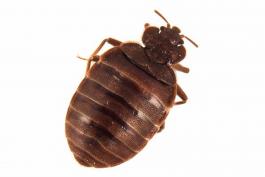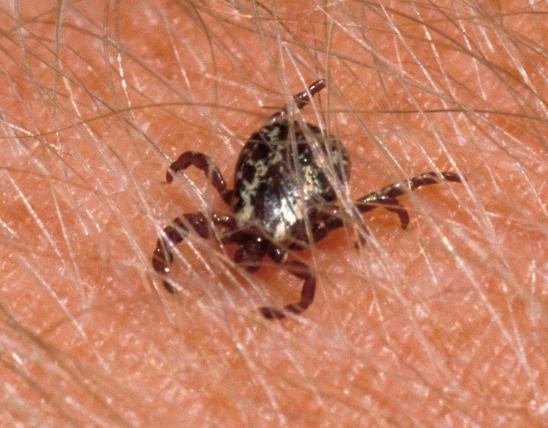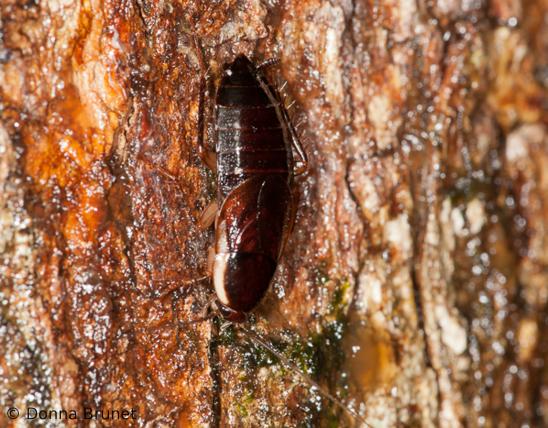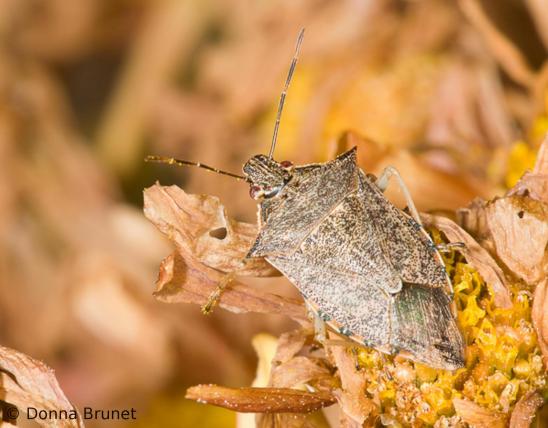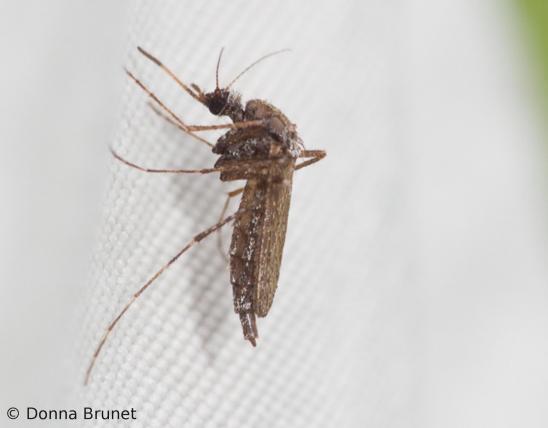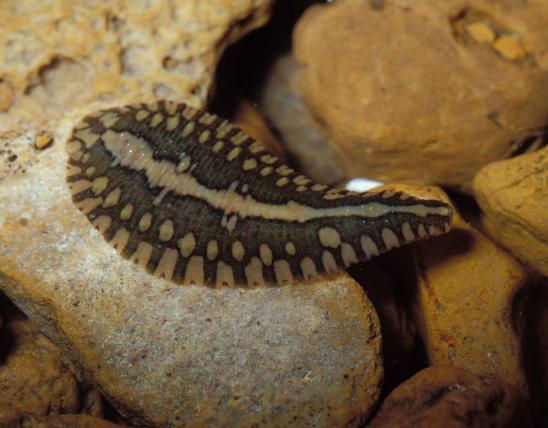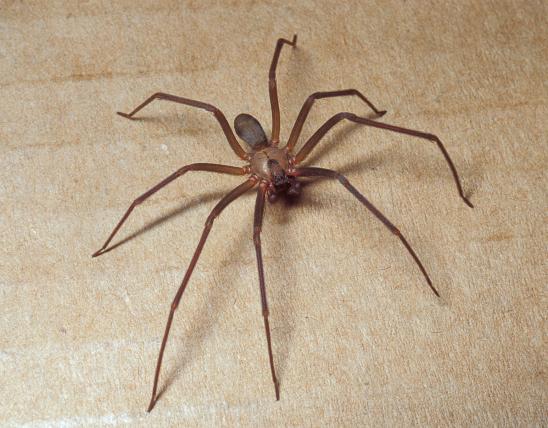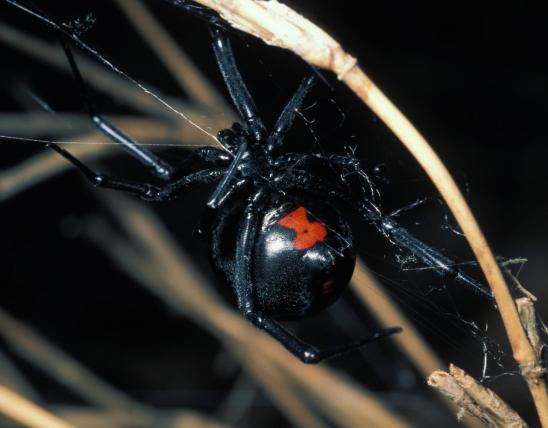
Adult bed bugs are reddish-brown or brown, oval, flattened, wingless bugs. The hind wings are absent and the front wings reduced to padlike structures. You are most likely to encounter them in or near a bed. Once exposed to light, they run quickly for cover.
There are many signs of their presence in a home, including telltale marks on bedsheets (reddish stains on sheets, caused by crushed bed bugs, and small black spots that may bleed into fabric, caused by the insects' excrement); bed bug eggs, empty egg cases, and shed skins; and presence of living bed bugs, which typically hide in tight crevices in bed frames and headboards, fabric folds or near the piping of box spring covers, behind nearby baseboards, behind electrical plates, etc.
Another sign of their presence can be the itchy welts that may result from their feeding. Chiggers, fleas, and other parasites can cause similar welts, however.
Similar species: Bed bugs are sometimes misidentified as small cockroaches; this is a mistake that costs many people time and money, as it allows the bed bug population to grow larger before treatment is sought.
Also, bat bugs are closely related, and they are nearly identical to bed bugs, but their primary host is bats. You need strong magnification to tell them apart: On bat bugs, the hairs along the edge of the pronotum (the shieldlike structure just behind the head) are as long as, or longer than, the width of the eye. On bed bugs, those hairs are shorter than the eye width. Bat bugs can infest human homes much like bed bugs, except they usually arrive on bats. If you have bat bugs, then you probably also have (or have had) bats in your home or attic, too. If your bats leave for some reason, then the hungry bugs left behind may wander around and find you. If you think you have bat bugs, consult a licensed exterminator to verify the identification. You will probably want to exclude bats from your home to prevent reinfestation.
Length: to less than ¼ inch; about the size of an apple seed.

Statewide; worldwide; wherever humans go.
Habitat and Conservation
Bed bugs live in homes, close to where humans sleep. Clutter and filth have nothing to do with their presence. Anyone can get them, rich as well as poor; sloppy or tidy housekeepers.
Mostly nocturnal, bed bugs feed on their sleeping hosts.
When not feeding, they squeeze into tight places near the bed, such as fabric seams, joints in the bed frame or other furniture, luggage, cracks behind baseboards, and joints and crevices of picture frames. A bedbug can squeeze into a space as thin as a credit card. If you can slip a credit card into a crevice, a bedbug can get in there.
Bed bugs tend to hide together in congregations. Exterminators use several techniques to handle infestations.
Food
Like most other true bugs (such as cicadas, aphids, and leafhoppers), bed bugs have strawlike mouthparts adapted for sucking liquids. In the case of human bed bugs, they drink blood from humans. Their bodies are flat but swell up with blood as they feed. After feeding, they return to their hiding places to digest the meal.
Various bed bug species may feed upon other mammals on occasion. Human bed bugs sometimes feed on pet dogs and cats. Likewise, bat bugs may sometimes feed upon humans.
Status
A human parasite. The bites cause itchy welts, but so far bed bugs are not known to transmit disease.
Effective extermination can be very expensive.
Bed bugs used to be common for millennia. In the last century, liberal use of pesticides made them rare in industrialized nations. But they have become resistant to many pesticides, and some of the strongest pesticides have been removed from the market due to their extreme toxicity. Meanwhile, as people travel around more and more, they carry bed bugs from place to place, in luggage and in furniture: from motels to condos to homes, and from apartment to apartment.
Life Cycle
Like many insects, bed bugs begin life in an egg cluster, then hatch and molt through several immature stages before a final molt, when they become a sexually mature adult. Bed bugs can breed prolifically, and they have been known to survive without eating for a year, which can make them hard to exterminate. If only one pregnant female or egg survives an extermination attempt, it can start a whole new colony. This explains how bed bugs get around: It only takes one or two, transported in a piece of used furniture or in a suitcase, to start an infestation.
Human Connections
Bed bugs challenge public health officials, exterminators, homeowners, landlords, and hotel owners. Because they were rare for so long, few of us know the signs of bed bugs and are not vigilant. We can carry them with us as we travel, move to new apartments, and reuse mattresses. Early detection is important. Property owners and apartment and hotel managers should be prepared for possible costs of extermination procedures.
One of the most effective ways of dealing with a bed bug infestation is heat treatment, where professional exterminators use giant heaters and blowers to heat the affected area of the home and its contents to more than 130F for about an hour or two. It can be expensive and requires careful preparation, but unlike chemical pesticides and fumigation, heat treatments can kill all life stages of the bugs — from the eggs to the nymphs to the adults — in a single day.
“Sleep tight, don’t let the bed bugs bite!” As children, many of us were tucked into bed with this soothing rhyme. But as bed bugs become more common, this saying might start keeping people awake. One of the causes for the recent rise in bed bugs is that people don’t notice them until they have a large infestation.
There are records of oldtime Ozarkers scattering the fresh leaves of black walnut, or of its close relative, butternut, about the house to repel insects such as bedbugs and fleas. Another Ozark folk remedy for bedbugs and fleas was — if snow happened to fall in May — to melt some of the snow in one's fireplace. Yet another method was to burn up a dirty old dishrag when you hear the first thunder in March.
Ecosystem Connections
Bed bugs are eaten by cockroaches, ants, assassin bugs, spiders, and house centipedes — but few people want to encourage those animals in their homes!
Interestingly, scientists speculate that human bed bugs evolved from bat bugs ages ago, when humans and bats slept in the same caves.

